In Depth: Fusion Strides at NIF
March 27, 2014
Fusion, the energy emitting process that takes place in our Sun, has long been sought after as an energy source created here on Earth. In February of 2014 the National Ignition Facility reported that more energy was released by fusion from the deuterium-tritium fuel they are using, than was absorbed by it!
This is a big deal, but much more work needs to be done scientists can not only generate a run-away fusion process within the fuel but also translate the process into a practical energy source.
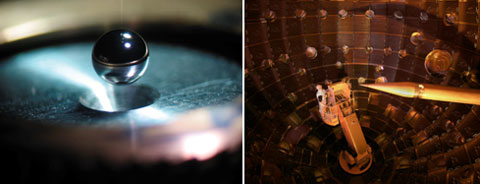
Left: A NIF target contains a polished capsule about two millimeters in diameter, filled with cryogenic (super-cooled) hydrogen (deuterium-tritium) fuel. Image courtesy of Lawrence Livermore National Laboratory.
Right: Inside the NIF target chamber, with a service module carrying technicians on the left, and the target positioner, which holds the target, is on the right.
Image Credit: Lawrence Livermore National Laboratory.
Fusion 101
Atomic nuclei naturally repel each other because their protons give them both a net positive charge. To achieve fusion, two nuclei must get close enough together so that the nuclear strong force, which is a very short distance force, can overcome the repulsive electrostatic force between the like charges of the protons.
This is only possible when the atoms collide at very high speeds or are accelerated toward each other by a large force. During a nuclear fusion reaction, the two nuclei fuse together to form a heavier element and often emit a neutron or proton and electromagnetic radiation.
The final mass of all the particles at the end of the reaction is less than the mass of all the particles before the reaction. The difference in mass is released as energy – motion energy of the particles produced and electromagnetic radiation. Scientists hope to harness this excess energy as a fuel source.
And this released energy can be enormous. It is over a million times more than the energy released in chemical processes and produces more energy per unit mass than fission, without all the bad byproducts. For example, ionizing a hydrogen atom (stripping its electron away) yields about 13.6 eV (electron Volts, a unit of energy).
Fission of a uranium 235 atom, on the other hand, releases an excess energy of about 200 million electron volts per atom, along with radioactive byproducts that take a long time to decay. Fusion of two hydrogen atoms releases about 17.6 million electron volts.
The fusion of two hydrogen atoms does not release as much energy as the splitting of a uranium 235 atom, but hydrogen is much lighter. If we considered the energy released per mass, fusing hydrogen would produce about four times that of uranium!
Two hydrogen atoms (one with a proton and a neutron called deuterium, and one with a proton and two neutrons called tritium) can combine together to form helium. This is similar to the primary process that occurs in our Sun. And as you can see and feel from the Sun’s radiation, this process emits a large amount of energy.
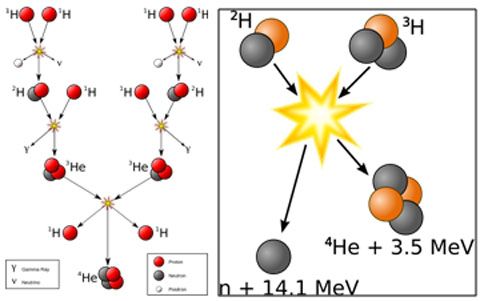
Left: The chain of reactions that occurs in our Sun that fuse hydrogen to helium and emitting rapidly moving particles and electromagnetic energy. Image Credit Cmglee, Wikimedia Commons.
Right: A diagram of deuterium (2H) and tritium (3H) colliding to form 4He and a neutron along with a lot of extra energy of the particles.
Image Credits: Cmglee and Wykis, respectively, via Wikimedia Commons.
Star Power in the Lab
The National Ignition Facility is working on compressing a spherical fuel capsule with a diameter of about 2 mm with 192 laser beams! The fuel is composed of cryogenically cooled deuterium and tritium. It is cooled to about 18.6˚ K (-255˚C or -427˚ F), which is about 0.8 K below its triple point temperature — the temperature where it the substance can exist in all three states: solid, liquid, and gas.
At this temperature, the deuterium-tritium is frozen, and forms a thin shell on the inside surface of a spherical container or capsule. The capsule surrounding the deuterium-tritium is a thin spherical plastic shell made of CH (carbon-hydrogen) and 2% silicon atoms. The researchers cool the deuterium-tritium fuel to compress it as much as possible, before they begin adding energy into it.
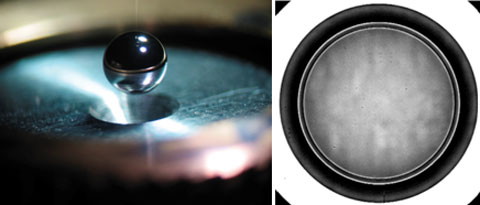
Left: A NIF target contains a polished capsule about two millimeters in diameter, filled with cryogenic (super-cooled) hydrogen (deuterium-tritium) fuel.
Right: An X-ray image of the capsule showing the deuterium-tritium fuel layer surrounded by the CH plastic capsule.
Image Credits: Lawrence Livermore National Laboratory
The spherical capsule is placed into a special cylindrical gold container called the hohlraum, shown below. The dark arm attached to its top and bottom is connected to the cryogenic system that keeps it cooled before the 192 laser beams fire on the target.
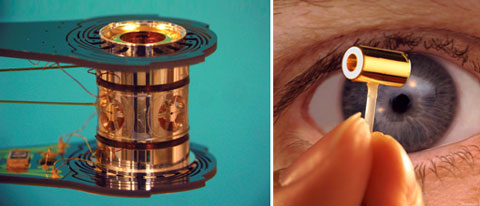
The NIF Hohlraum — A metallic case that holds the fuel capsule for NIF experiments. Target handling systems precisely position the target and freeze it to cryogenic temperatures of 18 Kelvins, or -427 degrees Fahrenheit, so that the fuel can be as compressed as much as possible. The hohlraum cylinder, which contains the NIF fusion fuel capsule, is just a few millimeters wide, about the size of a pencil eraser, with beam entrance holes at either end. The fuel capsule is the size of a small pea.
Image Credit: Lawrence Livermore Laboratory.
A weak red laser light pulse (carrying about a billionth of a joule of energy) is amplified 10 billion times, split, made uniform, smooth, amplified more, so that each beam is 4 million joules and is then converted to UV, just before entering the hohlraum. 192 beams of UV laser light enters through the holes on the top and bottom of the hohlraum. As these UV beams interact with the gold atoms in the hohlraum, X-rays are produced. The X-rays are absorbed by the plastic capsule, increasing the pressure in the plastic.
As the pressure increases, a series of shock waves (three in the case of the experiment described here) impinge on the fuel inside the capsule, and the deuterium-tritium fuel transitions from a solid to a plasma (ionized nuclei and free electrons mixed together). Then, the capsule and fuel begin to implode.
As the fuel moves toward the center, a hot spot forms, and fusion between the deuterium and tritium ions begins, emitting energetic neutrons and alpha particles (helium ions). The neutrons leave the fusing region (hot spot) without interacting much. The alpha particles (helium ion with charge +2) slow down during collisions with electrons (charge -1), transferring their energy to the electrons.
The electrons are much less massive than the alpha particle and hence move much faster after these collisions. The fast moving electrons interact with the deuterium and tritium ions in the plasma, transferring energy to them and increasing their local temperature. This causes the fusion process, which increases rapidly with temperature, to accelerate.
Meanwhile, the pressure and temperature inside increases until eventually the pressure at the center of the hot spot becomes so large that it stops the implosion. If the density and temperature within the hotspot increases enough, ignition can occur, which is equivalent to a run-away process where most or all of the fuel in the capsule fuses. This has not yet been achieved at the National Ignition Facility, but they are getting closer.
All of this must be done without mixing many C or H atoms from the capsule. It is not hard to imagine that some atoms could get knocked off of the capsule and mix with the fuel.
When this mix or contamination of the fuel occurs, some of the x-ray energy is radiated away which causes cooling of the hot spot, which prevents the ongoing fusion process. In order to reduce this issue, the researchers in reference 1 decided to adjust the lasers to deliver energy in what is called a “high-foot” pulse.
This pulse delivers a large amount of the laser power during the beginning of the pulse, and then drops off before rising again to peak power, with the overall time the pulse is applied being shorter than previous experiments. The high-foot pulse causes the radiation temperature to increase early on, and reduces the instability that can lead to mixing of the shell atoms with the fuel.
Another feature the researchers utilized was adjusting the wavelengths of different laser beams so that they could transfer energy between beams and localize the energy to where they would achieve the most spherical hot spot within the fuel.
The scientists observed that more energy was released by fusion than was delivered to the fuel!1 For the first time, the energy released by fusion was nearly double the energy due to self-heating from the implosion, which is very exciting because it means they are much closer to achieving the run-away process.
In past experiments, researchers were not even close to getting more energy released by the fuel than was put into the fuel, and an extremely small amount of the energy released was due to self-heating, most being due to compression of the fuel.
In this high-foot experiment,1 the total energy released by the fuel is about 1.5 times the energy absorbed by the capsule, and roughly half the released energy is from self-heating! This can be seen in the graph below for #131119. However, the amount of energy released by fusion was still less than the energy that was delivered to the capsule containing the fuel.
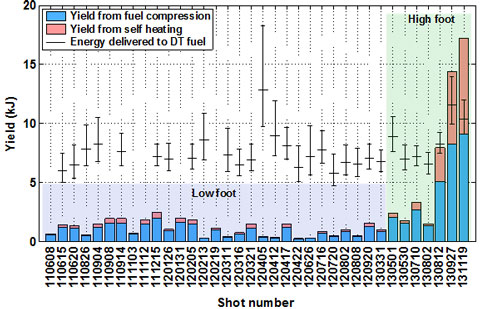
Energy released (yield energy) versus experimental tries. The last result (labeled 131119) is described above.
Image Credit: Lawrence Livermore Laboratory.
Looking Ahead
The researchers state in reference 1 that future efforts could involve other methods to better control the capsule shape during the implosion, try different materials for the capsule, and further modify the laser pulse-shape.
References and Resources
1. Hurricane, O.A. et al., Fuel gain exceeding unity in an inertially confined fusion implosion, Nature, 506 (2014)http://www.nature.com/nature/journal/v506/n7488/full/nature13008.html
2. Park, H.-S. et al. High-Adiabat High-Foot Inertial Confinement Fusion Implosion Experiment on the National Ignition Facility, Phys Rev. Lett 112, 055001 (2014)
http://physics.aps.org/featured-article-pdf/10.1103/PhysRevLett.112.055001
3. Rose, S. J. Viewpoint: Encouraging Signs to the Path of Fusion, Physics
http://physics.aps.org/articles/v7/13
4. Dittrich, T.R. et al. Design of a High-foot High-Adiabat ICF Capsule for the National Ignition Facility, Phys. Rev. Lett., 112, 055002 (2014).
http://journals.aps.org/prl/abstract/10.1103/PhysRevLett.112.055002
—H.M. Doss














